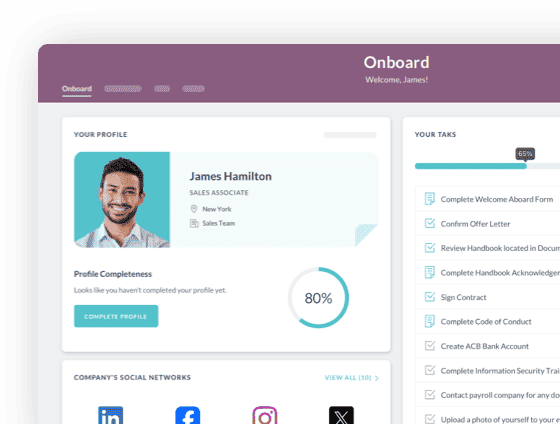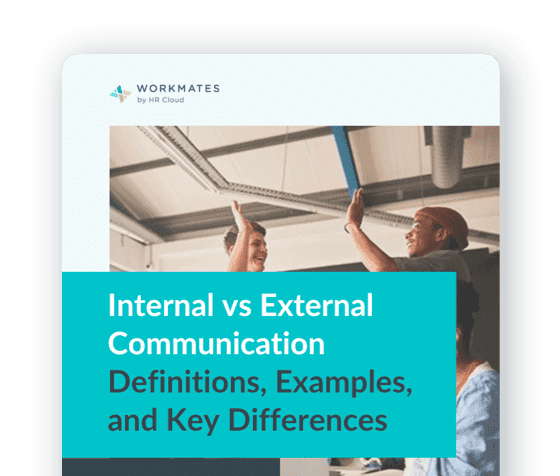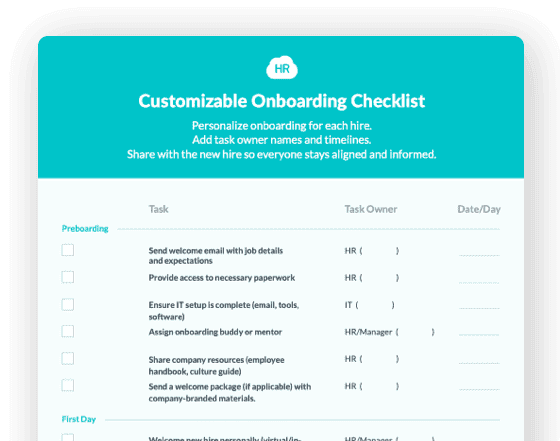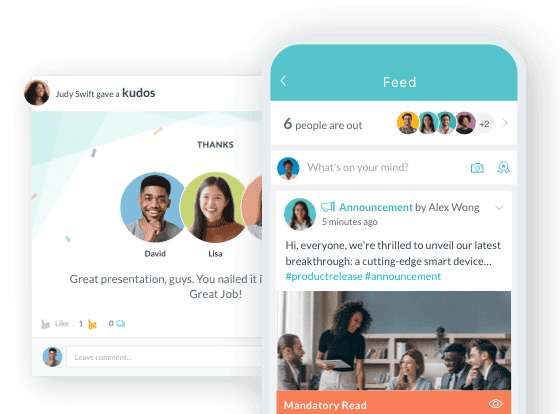How Communication Impacts the Recruitment Process
.png)


 Cut onboarding time
by 60%—here's the
Ultimate Checklist
that helped do it.
Cut onboarding time
by 60%—here's the
Ultimate Checklist
that helped do it.

Effective communication plays a crucial role in the recruitment process in today's competitive job market.
35% of respondents in Employ’s 2022 Job Seeker Nation Report cite poor communication and responsiveness from prospective employers as a key frustration within the job search process. A further 47% say great communication makes for a positive recruitment experience. These statistics highlight the importance of not only communication but also employee experience and job satisfaction throughout the hiring journey.
A well-executed recruitment communication strategy is thus essential for attracting and engaging top talent.
Here, we explore how effective communication affects your employee recruitment process, including its impact on reward and recognition. We’ll also discuss how to enhance your communication strategy for successful talent acquisition and staff retention.
What is a Recruitment Communication Strategy?
A recruitment communication strategy is a plan mapping out how your company interacts with job seekers throughout the recruitment process. It highlights the communication modes and measures needed to adequately dispense information to candidates. This strategy should also consider how to convey information about employee rewards programs, as these can be significant factors in attracting top talent.
A clear recruitment communication strategy helps prevent disorganized or unstructured interactions between you and your candidates. It also eliminates sloppiness, unprofessionalism, and content gaps—all factors that may discourage talent from working for your company and negatively impact intrinsic motivation.
Why Communication Matters During Employee Recruitment .png?width=3096&height=1965&name=What%20is%20a%20Recruitment%20Communication%20Strategy_%20-%20visual%20selection%20(2).png)
Here’s how two-way communication between your company and potential talent can improve employee recruitment and eventual retention.
Attracting and Engaging Top Talent
Well-written job descriptions accurately reflect the role's responsibilities, requirements, and perks, which will be much more attractive to the right kind of candidate, so clear and compelling communication is vital to attract the highest quality applicants. This includes highlighting any recognition and rewards opportunities available within the organization.
Furthermore, effective communication during the initial stages of the recruitment process creates a positive impression, and a great candidate experience improves your chances of getting the job seeker to work with your organization.
You may use several different channels, such as job advertisements, company websites, and recognition platforms, to communicate available opportunities and showcase your flexible rewards. It’s essential to ensure that these are readily accessible to your ideal employee so you’re attracting the right caliber of candidates.
 Post Jobs, Evaluate Candidates, and Hire the Best with Our Applicant Tracking System
Post Jobs, Evaluate Candidates, and Hire the Best with Our Applicant Tracking System
Building a Positive Employer Brand
Effective communication during recruitment contributes to shaping and strengthening your brand as an employer. This includes how you communicate your approach to employee appreciation and recognition.
A poor employer brand can discourage candidates from pursuing opportunities with your company. Plus, they may share their negative opinions with other job seekers and harm your ability to get top talent applying at all.
In this regard, communication impacts the recruitment process and shapes your employer's brand. As an HR team member, how you communicate your company's mission, values, culture, growth opportunities, and employee recognition ideas matters a lot.
Clearly communicating organizational values and reward systems, for example, will differentiate your brand from its competitors and appeal to candidates who align with your vision.
In addition, prompt and transparent communication throughout the recruitment process demonstrates respect for your applicants. It also enhances the candidate’s perception of your organization, promoting a positive employer brand reputation and potentially boosting extrinsic motivation.
Ensuring a Smooth and Efficient Hiring Process
Clear communication makes the recruitment process seamless and frictionless as well. For example, timely updates and regular communication with candidates will help manage their expectations, keep them engaged, and maintain transparency. This approach can also help set the stage for future peer-to-peer recognition within the organization.
Open and transparent communication surrounding the interview process will help prevent confusion and frustration. Well-communicated expectations enable candidates to prepare for each stage, leading to better outcomes on both sides of the hiring process. This can include discussing how performance management and rewards platforms work within the company.
Proven Steps to Improve Your Communication Strategy .png?width=2088&height=1290&name=What%20is%20a%20Recruitment%20Communication%20Strategy_%20-%20visual%20selection%20(1).png)
The key to leveraging communication for recruitment is to have a solid strategy for it. Below, we’ll walk you through some key steps for strengthening your recruitment communication plan, which can also support your employee recognition program.
Develop a Comprehensive Recruitment Communication Plan
Strategy is all about having a detailed plan for how we recognize and communicate with potential candidates. This plan should outline how candidates will receive recognition throughout the recruitment process, ensuring they feel valued from the start. Recognition is a crucial aspect of building a positive employer brand and attracting top talent.
When developing your plan, consider the following elements:
-
Define clear communication channels: Utilize a mix of email, phone calls, and potentially a dedicated rewards platform to keep candidates informed and engaged.
-
Set communication frequency: Determine how often you'll update candidates to avoid information gaps without causing recognition fatigue.
-
Personalize your approach: Tailor your communication style to different candidate personas, considering their preferences and the role they're applying for.
-
Incorporate formal recognition: Plan for specific points in the recruitment process where you can formally acknowledge candidates' efforts and achievements.
-
Prepare for feedback: Establish a system for candidates to provide feedback on the recruitment process, which can help you refine your communication strategy and improve the overall employee experience.
By implementing these steps and focusing on effective communication, you can create a recruitment process that not only attracts top talent but also sets the foundation for long-term staff retention. Remember, a well-communicated recruitment process is often the first step in building a strong, motivated workforce.
Optimize Job Descriptions
A job description is how you help candidates understand the role they’ll occupy in your company. It tells them what they need to understand about the job, the business, and everything else they must know to function well in the role.
As such, crafting job descriptions that accurately reflect the role and your company culture is crucial. Clearly outline the responsibilities, qualifications, and expectations you want to see in the ideal candidate. Doing this will help attract the right sort of applicants.
In addition, use language that’s engaging and easy to understand when creating your job description. Aim for simplicity in your messaging, avoiding jargon and unnecessary complexity.
It’s good practice to highlight the benefits and growth opportunities associated with the role. With this done, you should end the message with a clear call for candidates to apply.
Streamline Candidate Communication
The quality of your communication lies in how much information you can dispense with as little content as possible.
Job seekers shouldn’t have to read several pages of text or watch a lengthy video to get all the information they need to apply for the role. It’s about saying less and telling more.
You want to streamline all communications, cut out any excess, and only put out cogent information when necessary. More importantly, personalize communication whenever this is feasible to make candidates feel valued and respected.
In addition, establish clear communication channels for candidates to reach out with their questions or concerns. Respond promptly to inquiries and provide regular updates throughout the hiring process.
Lastly, leverage technology to automate communication where possible. For example, you may send automated confirmations, interview reminders, or status updates to candidates via business text messaging services or email.
Train Recruiters and Hiring Managers on Effective Communication
Your strategy is only as good as its implementation. While it may sound impressive on paper, the individuals rolling out your plan may fluff its execution, rendering it useless. As such, you must train the rest of the HR team on effective communication.
Equip your recruiters and hiring managers with the necessary communication skills to fully engage with prospective employees. Also, train them on active listening, empathy, and clear messaging.
Encourage recruiters to provide constructive feedback to candidates even if they’re not selected. Doing this helps you foster positive relationships and maintain a positive employer brand.
Gather Feedback and Iterate
Feedback is necessary to adjust and improve your strategy. That’s why it's integral to your overall recruitment communication plan.
Regularly collect feedback from candidates about their experience during the recruitment process. Use these reviews to identify areas for improvement and make necessary adjustments to your communication strategy.
Continuously iterate and refine your approach to ensure your recruitment communication aligns with candidate expectations and market trends.
Optimize Your Recruitment Communication Strategy to Attract Top Talent
Now that you understand the effect of communication on the recruitment process, you should begin implementing steps to solidify your strategy. The tips we discussed above will help you improve your interactions with potential employees.
Admittedly, communication is only one part of the puzzle when it comes to creating a great recruitment experience. Nonetheless, it’s a crucial piece, which you must get right to improve your company’s overall hiring process.
 Discover how our HR solutions streamline onboarding, boost employee engagement, and simplify HR management
Discover how our HR solutions streamline onboarding, boost employee engagement, and simplify HR management
Author Bio:
This article is written by a marketing team member at HR Cloud. HR Cloud is a leading provider of proven HR solutions, including recruiting, onboarding, employee communications & engagement, and rewards & recognition. Our user-friendly software increases employee productivity, delivers time and cost savings, and minimizes compliance risk.

Keep Reading
Specialized Onboarding Software for Healthcare to Reduce Admin Work and Scale Hiring Fast
Imagine this: a women’s health clinic hires two new nurses, only to lose both within
A Closer Look at HR Cloud-ADP Integrations
ADP is the gold standard for payroll and core HR management. But if you’ve ever tried to
Retention Reset: How to Keep Your Best Talent in 2025
More employees are walking away from their jobs in 2025 not just for better pay, but for
Like What You Hear?
We'd love to chat with you more about how HR Cloud® can support your business's HR needs. Book Your Free Demo

Build a Culture of Recognition. Boost Engagement. Guaranteed.
Workmates empowers employees to stay informed, connected, and appreciated—whether they’re on the front line, in the office, or remote. Recognition drives 12x higher engagement.Trusted by industry leaders in every sector




Cut Onboarding Costs by 60%.
Take the confusion and follow-ups out of onboarding with automated workflows, digital forms, and structured portals—so new hires ramp faster 3X quicker.Trusted by industry leaders in every sector




